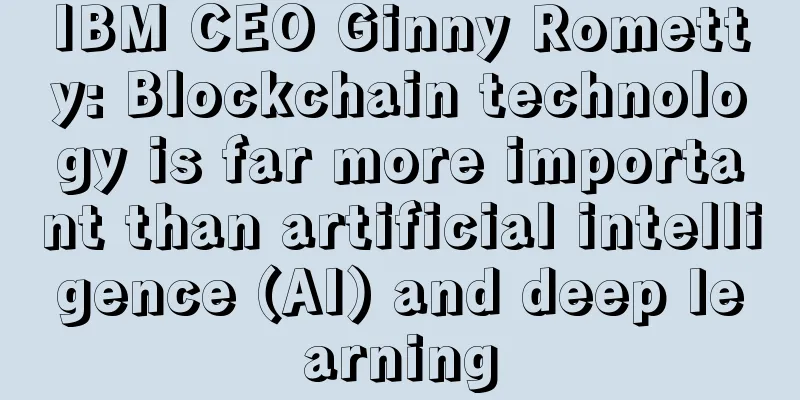IBM CEO Ginny Rometty: Blockchain technology is far more important than artificial intelligence (AI) and deep learning

|
IBM President and CEO Ginni Rometty believes that blockchain technology is far more important than artificial intelligence (AI) and deep learning. Speaking at the NASSCOM India Leadership Forum (NILF) earlier this month, an annual event where business and industry leaders come together to discuss the transformative ideas and potential of disruptive technologies, Rometty said blockchain technology will transform the financial industry in the same way that the internet transformed the information industry. Rometty further emphasized that cognition is much more important than AI because cognitive technologies, such as blockchain, can enable individuals to expand and evaluate data in a more efficient and practical ecosystem. Essentially, Rometty believes AI enables individuals to make better decisions, while machine learning helps interpret patterns. However, she noted that blockchain and IBM blockchain technology can bring much more to the table. Rometty said:
Ambiguous and confusing business modelBased on Rometty’s speech at NILF, it is more difficult to analyze the efficiency and practicality of IBM’s blockchain project, especially if you take into account the future prospects Rometty mentioned. In her speech, Rometty went on to highlight the potential for blockchain technology to be used to manage millions of records and disrupt data-centric industries such as healthcare. However, blockchain technology was not designed and built to move such large data sets. In fact, technically speaking, blockchain technology is an inefficient data processing platform. The maintenance cost of this platform is high and challenging, specifically because it runs on a complex cryptographic system. Miners must contribute computing power to run a decentralized and immutable blockchain network. Still, the kind of cognitive technologies Rometty described at NILF are absolutely necessary, as there are many multibillion-dollar industries that are starving for cloud-based data processing platforms, applications and networks. However, blockchain technology should not become the core technology and basic protocol of such cloud data processing networks. R3CEV, the world's largest blockchain alliance, has already moved away from this technology after admitting that blockchain technology is not what they are trying to obtain. The immutable and decentralized nature of the Bitcoin blockchain can benefit many use cases and business models. One of these models is to verify identity in an immutable and transparent blockchain network. However, these platforms cannot currently be deployed on the Bitcoin blockchain network. This requires alternative solutions such as sidechains or other methods of connecting the Bitcoin network to off-chain networks. Rometty said:
Looking back at the failed attempts of R3CEV and other blockchain consortiums, it seems as if blockchain should not become a foundational technology, and if IBM intends to successfully commercialize blockchain technology, it should focus on exploring more realistic blockchain use cases. |
<<: Coin Zone Trends: Bitcoin Price Trends Based on Big Data This Week (2017-02-24)
>>: Blockchain company Storj receives $3 million in seed round funding, targeting enterprise cloud
Recommend
Is it true that a woman with a man's eye on her thumb will have a good fate?
The lines on people's palms are intricate. Di...
What is the best shape of buttocks to attract wealth and good fortune to your husband?
What is the best shape of buttocks to attract wea...
What does a red mole on the hand mean? Moles on the hand and fate
Each of us has some moles on our bodies. From the...
People with these palm lines can start from scratch
People with these palm lines can start from scrat...
Bitcoin network difficulty hits record high, how long can miners hold out?
Author | Joyce It is difficult for retail investo...
What are the effects of a deep wisdom line?
Although the wisdom line is not the most importan...
Ten characteristics of a man's wealth and honor
Every woman hopes to find a handsome and capable ...
Bitcoin crisis needs to be faced positively to maintain confidence
The origin of Bitcoin is still unclear, but some ...
Palmistry obstacle line diagram palmistry lines analysis
People all want to have good luck, but sometimes ...
What kind of face is most likely to cheat on women?
Cheating has gradually become a common occurrence...
Exclusive: Local authorities urgently investigate ICO risks, 60 platforms are included in the investigation list
The chaos in ICO has attracted high attention fro...
The face of a person who always takes chances
Some things can be avoided on the first day, but ...
What does a crooked mouth mean?
What does a crooked mouth mean? Statement: The pi...
What does a mole on a man’s chin mean? It means his love life will be bumpy!
Is it good for a man to have a mole on his chin? ...
Bank of China and Tencent test new blockchain research
The Bank of China has partnered with Tencent, one...









